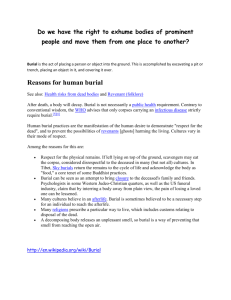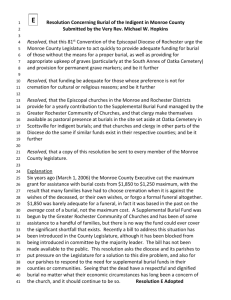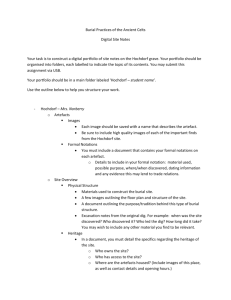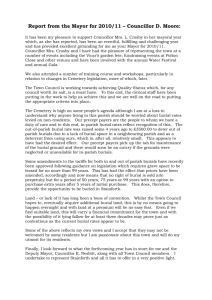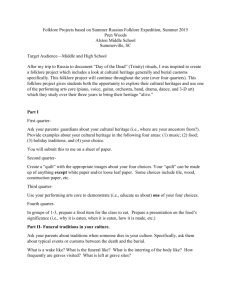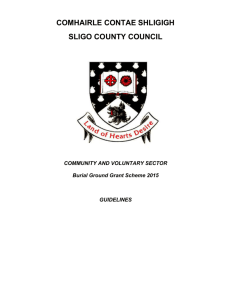Article #2 (see next page for directions)
advertisement
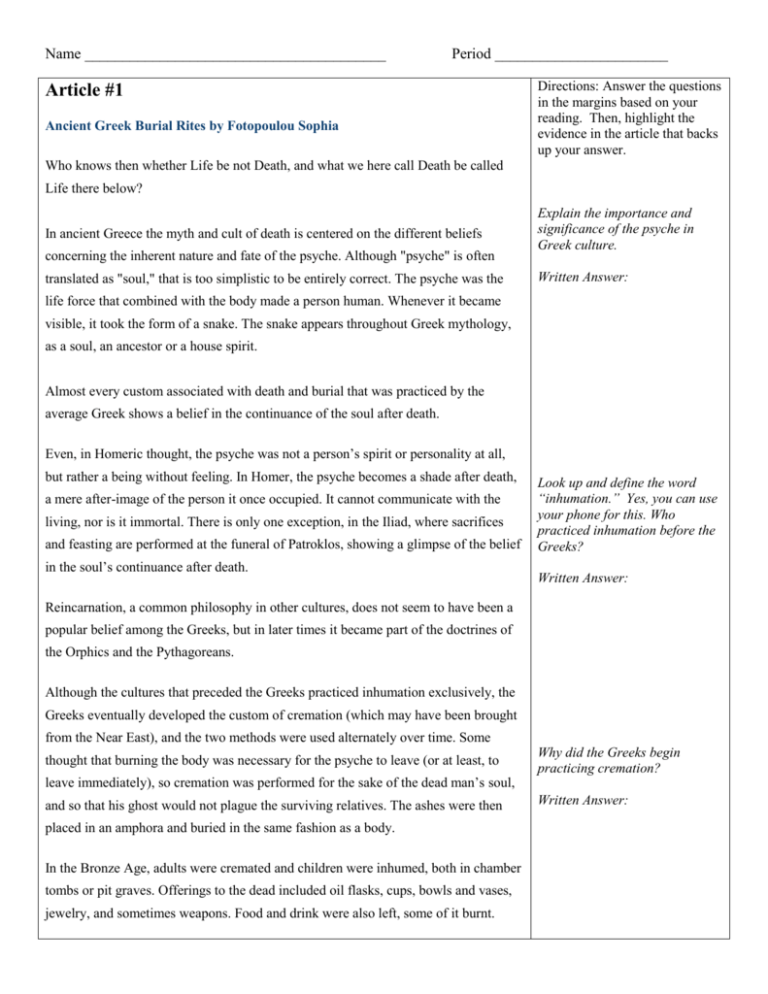
Name ________________________________________ Period _______________________ Article #1 Ancient Greek Burial Rites by Fotopoulou Sophia Directions: Answer the questions in the margins based on your reading. Then, highlight the evidence in the article that backs up your answer. Who knows then whether Life be not Death, and what we here call Death be called Life there below? In ancient Greece the myth and cult of death is centered on the different beliefs concerning the inherent nature and fate of the psyche. Although "psyche" is often translated as "soul," that is too simplistic to be entirely correct. The psyche was the Explain the importance and significance of the psyche in Greek culture. Written Answer: life force that combined with the body made a person human. Whenever it became visible, it took the form of a snake. The snake appears throughout Greek mythology, as a soul, an ancestor or a house spirit. Almost every custom associated with death and burial that was practiced by the average Greek shows a belief in the continuance of the soul after death. Even, in Homeric thought, the psyche was not a person’s spirit or personality at all, but rather a being without feeling. In Homer, the psyche becomes a shade after death, a mere after-image of the person it once occupied. It cannot communicate with the living, nor is it immortal. There is only one exception, in the Iliad, where sacrifices and feasting are performed at the funeral of Patroklos, showing a glimpse of the belief in the soul’s continuance after death. Look up and define the word “inhumation.” Yes, you can use your phone for this. Who practiced inhumation before the Greeks? Written Answer: Reincarnation, a common philosophy in other cultures, does not seem to have been a popular belief among the Greeks, but in later times it became part of the doctrines of the Orphics and the Pythagoreans. Although the cultures that preceded the Greeks practiced inhumation exclusively, the Greeks eventually developed the custom of cremation (which may have been brought from the Near East), and the two methods were used alternately over time. Some thought that burning the body was necessary for the psyche to leave (or at least, to leave immediately), so cremation was performed for the sake of the dead man’s soul, and so that his ghost would not plague the surviving relatives. The ashes were then placed in an amphora and buried in the same fashion as a body. In the Bronze Age, adults were cremated and children were inhumed, both in chamber tombs or pit graves. Offerings to the dead included oil flasks, cups, bowls and vases, jewelry, and sometimes weapons. Food and drink were also left, some of it burnt. Why did the Greeks begin practicing cremation? Written Answer: By the Hellenistic Period, inhumation had become more common than cremation again. It is in this period that the coin, ovolos, offering to Charon is first seen. somehow to an empty grave called a cenotaph, where a stone represented the person. Why was it important for the Greeks to be buried in the homeland? Connect this to the Iliad. Relatives tended cenotaphs in the same manner as real graves. Although women were Written Answer: It was very important to the Greeks to be buried in their homeland by their close family. When a person died away from home, their soul had to be called back a crucial element of the rituals, only women who were closely related to the deceased or over the age of sixty were allowed to participate. The burial rites began on the day after death. The eyes and mouth of the dead person were closed, the body was washed and anointed, with a laurel branch used to sprinkle substituted with a fake coin called “ghost money” which was left in the mouth, hand Explain the purpose of the coin being placed over the eyes of the dead in Greek culture. or loose in the grave). The body was then wrapped in a linen shroud and crowned with Written Answer: sanctified water. A coin for Charon was fixed between the teeth (though later this was garlands, and sometimes it was laid on vine branches. Finally, the body was laid on a bier, with its feet facing the door, in the house for a whole day; this was called prothesis. Women lamented, and men came to pay their respects. On the third day after death, before sunrise, the corpse was brought out in a procession to the cemetery; this was called ekphora. The women displayed violent exhibitions of ritual position, with their hands placed on their heads. Sometimes the mourners made Women publicly and openly grieved for the dead. How does Andromache do this at the end of Book XXII? themselves physically unclean as an expression of their grief. Written Answer: grief to please the dead spirit and sang a funeral dirge; but in some places laws limited the noise during the procession. Vase paintings show female mourners in a particular At the cemetery, the body was lowered into the grave, and libations were made and offerings left. Cups were common as offerings, perhaps because the dead were often referred to as thirsty. When the dirt was put over the body, seeds were scattered upon it, to return that patch of land to the use of the living. A gravestone of some sort was erected on the burial mound, sometimes a phallus or a herm (a primitive idol of Hermes, the guide of souls). In older times, trees were planted around the grave. The graves, and even entire cemeteries, were often oriented to the West, where the land of the dead was said to lie. The family then returned to the home of the deceased, which was marked by a particular kind of vessel, both as a warning to others that the house was unclean, and for use as a receptacle for pure water (often from the sea). Water and fire from the house were polluted, and had to be brought in from outside. The family purified themselves and put on garlands. Then they sat down to a funeral feast, called a perideipnon. At this feast, which in older times was held at the graveside, the dead man was said to be present, and the diners would speak only of praise for him. This was the last consecutive day of funeral rites for most people; the funerals of very important men sometimes ended in athletic contests. Explain the activities performed during the mourning period in Greek culture. On the third day after the funeral, food offerings were left at the grave, and again on Written Answer: the ninth day, which was commonly the end of the mourning period. However, worship of the dead and especially one’s ancestors did not end at funerals; it was a lifelong duty, especially for a dead man’s oldest son. Centered around the grave spot, the commemoration of a particular deceased family member took place on the dead man or woman’s birthday, as well as the anniversary of his or her death. The latter was a very important occasion, which included a visit to the tomb and the offering of flowers and ribbons. also feared, and people would pass by graves silently, so as to avoid attracting the How did the death of a family member affect future generations? Do you think this is honoring the dead or being excessive? attention of the soul within. This custom, as well as the prevalence of rites performed Written Answer: Ancestors were thought to be able to help give fertility of all kinds, and were often sacrificed to and prayed to for good crops and fertile wombs. However, the dead were at the graves themselves, seems to show that they believed at least some aspect of the psyche remained in the gravesite. Offerings to these deities, and other spirits of the dead, included pomegranates, cooked vegetables and seeds, pigs, rams, and roosters, though only female or castrated animals were sacrificed. Food that fell to the ground was also left for them. Sometimes sacrifices were buried or thrown in pits or even graves, to be closer to the underworld. And offerings were sometimes “killed” or ruined before being given, because it was thought that everything was reversed in the underworld, and therefore a thing must be broken for it to be whole there. Why were sacrifices and offerings made by the Greeks after the death of a loved one? What kinds of things did the Greeks sacrifice/offer the gods? Written Answer: Article #2 (see next page for directions) Not all cultures believe in burying the dead in the ground. Here are 10 unique ceremonies from around the world. THE MODERN DICTIONARY defines the word ‘burial’ as placing a body in the ground. But burying the deceased was not always the case. Just as primitive man has long worshiped the four elements of Earth, Sky, Water, and Fire, so too have these elements taken their place in burial practices as diverse as the different tribes of the earth. The way mankind deals with its dead says a great deal about those left to carry on. Directions for Article #2: Read Burial practices are windows to a culture that speak volumes about how it lives. the 11 burial customs from different cultures. Choose 5 or As we are told in Genesis, man comes from dust, and returns to it. We have found the 10 to highlight and write many different ways to return. Here are 10 that I found particularly fascinating: comments about. As you read, Air Sacrifice – Mongolia highlight what makes the custom unique (what you found Lamas direct the entire ceremony, with their number determined by the social interesting or weird about it). standing of the deceased. They decide the direction the entourage will travel with the For the comments, explain (1) body, to the specific day and time the ceremony can happen. why it is interesting to you and (2) how this custom is similar Mongolians believe in the return of the soul. Therefore the lamas pray and offer food and/or different to another to keep evil spirits away and to protect the remaining family. They also place blue custom either in the article, in the stones in the dead persons bed to prevent evil spirits from entering it. Greek burial article, or another custom you know about from No one but a lama is allowed to touch the corpse, and a white silk veil is placed over the face. The naked body is flanked by men on the right side of the yurt while women are placed on the left. Both have their respective right or left hand placed under their heads, and are situated in the fetal position. The family burns incense and leaves food out to feed all visiting spirits. When time comes to remove the body, it must be passed through a window or a hole cut in the wall to prevent evil from slipping in while the door is open. The body is taken away from the village and laid on the open ground. A stone outline is placed around it, and then the village dogs that have been penned up and not fed for days are released to consume the remains. What is left goes to the local predators. The stone outline remains as a reminder of the person. If any step of the ceremony is left out, no matter how trivial, bad karma is believed to ensue. Sky Burial – Tibet This is similar to the Mongolian ceremony. The deceased is dismembered by a rogyapa, or body breaker, and left outside away from any occupied dwellings to be consumed by nature. To the western mind, this may seem barbaric, as it did to the Chinese who outlawed another culture. the practice after taking control of the country in the 1950s. But in Buddhist Tibet, it makes perfect sense. The ceremony represents the perfect Buddhist act, known as Jhator. The worthless body provides sustenance to the birds of prey that are the primary consumers of its flesh. To a Buddhist, the body is but an empty shell, worthless after the spirit has departed. Most of the country is surrounded by snowy peaks, and the ground is too solid for traditional earth internment. Likewise, being mostly above the tree line, there is not enough fuel for cremation. Pit Burial – Pacific Northwest Haida Before white contact, the indigenous people of the American northwest coast, particularly the Haida, simply cast their dead into a large open pit behind the village. Their flesh was left to the animals. But if one was a chief, shaman, or warrior, things were quite different. The body was crushed with clubs until it fit into a small wooden box about the size of a piece of modern luggage. It was then fitted atop a totem pole in front of the longhouse of the man’s tribe where the various icons of the totem acted as guardians for the spirits’ journey to the next world. Written history left to us by the first missionaries to the area all speak of an unbelievable stench at most of these villages. Today, this practice is outlawed. Viking Burial – Scandinavia We have all seen images of a Viking funeral with the body laid out on the deck of a dragon ship, floating into the sunset while warriors fire flaming arrows to ignite the pyre. While very dramatic, burning a ship is quite expensive, and not very practical. What we do know is most Vikings, being a sea faring people, were interred in large graves dug in the shape of a ship and lined with rocks. The person’s belongings and food were placed beside them. Men took their weapons to the next world, while women were laid to rest wearing their finest jewelry and accessories. If the deceased was a nobleman or great warrior, his woman was passed from man to man in his tribe, who all made love to her (some would say raped) before strangling her, and placing her next to the body of her man. Thankfully this practice is now, for the most part, extinct. Fire Burial – Bali On the mostly Hindu Isle of Bali, fire is the vehicle to the next life. The body or Mayat is bathed and laid out on a table where food offerings are laid beside it for the journey. Lanterns line the path to the persons hut to let people know he or she has passed, and act as a reminder of their life so they are not forgotten. It is then interred in a mass grave with others from the same village who have passed on until it is deemed there are a sufficient number of bodies to hold a cremation. The bodies are unearthed, cleaned, and stacked on an elaborate float, gloriously decorated by the entire village and adorned with flowers. The float is paraded through the village to the central square where it is consumed by flames, and marks the beginning of a massive feast to honor and remember the dead. Spirit Offerings – Southeast Asia Throughout most of Southeast Asia, people have been buried in the fields where they lived and worked. It is common to see large stone monuments in the middle of a pasture of cows or water buffalo. The Vietnamese leave thick wads of counterfeit money under rocks on these monuments so the deceased can buy whatever they need on their way to the next life In Cambodia and Thailand, wooden “spirit houses” sit in front of almost every hut from the poorest to the most elaborate estate. These are places where food and drink are left periodically for the souls of departed relatives to refuel when necessary. The offerings of both countries also ask the spirits of the relatives to watch over the lands and the families left behind. Predator Burial – Maasai Tribe The Maasai of East Africa are hereditary nomads who believe in a deity known as Enkai, but this is not a single being or entity. It is a term that encompasses the earth, sky, and all that dwells below. It is a difficult concept for western minds that are more used to traditional religious beliefs than those of so-called primitive cultures. Actual burial is reserved for chiefs as a sign of respect, while the common people are simply left outdoors for predators to dispose of, since Maasai believe dead bodies are harmful to the earth. To them when you are dead, you are simply gone. There is no after life. Skull Burial – Kiribati On the tiny island of Kiribati the deceased is laid out in their house for no less than three days and as long as twelve, depending on their status in the community. Friends and relatives make a pudding from the root of a local plant as an offering. Several months after internment the body is exhumed and the skull removed, oiled, polished, and offered tobacco and food. After the remainder of the body is re-interred, traditional islanders keep the skull on a shelf in their home and believe the native god Nakaa welcomes the dead person’s spirit in the northern end of the islands. Cave Burial – Hawaii In the Hawaiian Islands, a traditional burial takes place in a cave where the body is bent into a fetal position with hands and feet tied to keep it that way, then covered with a tapa cloth made from the bark of a mulberry bush. Sometimes the internal organs are removed and the cavity filled with salt to preserve it. The bones are considered sacred and believed to have diving power. Many caves in Hawaii still contain these skeletons, particularly along the coast of Maui. Ocean Burial Since most of our planet is covered with water, burial at sea has long been the accepted norm for mariners the world over. By international law, the captain of any ship, regardless of size or nationality has the authority to conduct an official burial service at sea. The traditional burial shroud is a burlap bag, being cheap and plentiful, and long in use to carry cargo. The deceased is sewn inside and is weighted with rocks or other heavy debris to keep it from floating. If available, the flag of their nation covers the bag while a service is conducted on deck. The body is then slid from under the flag, and deposited in Davy Jones locker. In olden days, the British navy mandated that the final stitch in the bag had to go through the deceased person’s lip, just to make sure they really were dead. (If they were still alive, having a needle passed through their skin would revive them). It is quite possible that sea burial has been the main form of burial across the earth since before recorded history. The Final Frontier Today, if one has enough money, you can be launched into space aboard a private commercial satellite and a capsule containing your ashes will be in permanent orbit around the earth. Perhaps this is the ultimate burial ceremony, or maybe the beginning of a whole new era in which man continues to find new and innovative ways to invoke spirits and provide a safe passage to whatever awaits us at the end of this life. After Reading Questions (on your own paper – staple to this packet when you are finished): 1) In reading about the burial customs of the Greeks and from other cultures, explain why it is so important for Priam to go ask Achilleus for the body of his son. 2) After reading about the importance of burial customs, what does it say about Achilleus’ character that he was unwilling to give back Hektor’s body? What character archetype does Achilleus’ actions make him in the scene where he refuses Hektor’s final plea? 3) Do you think Achilleus should have dragged Hektor’s body after killing him? Why? 4) Do you think soldiers should honor the customs/beliefs of their enemy? Explain your opinion.
